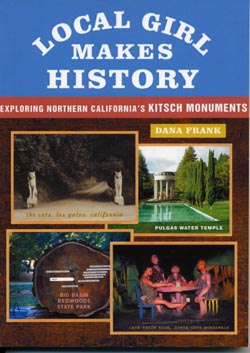How does a 2,000 year-old tree at Big Basin Redwoods State Park trace the history of imperialism? Who are the "Cave People" at the Santa Cruz Boardwalk? Why were two giant white stone cats erected by Highway 17 in Los Gatos? What is the real story behind the Greco-Roman-style Pulgas Water Temple built on the San Francisco Peninsula?
These questions and more are revealed in Local Girl Makes History: Exploring California's Kitsch Monuments, a new book by UC Santa Cruz historian Dana Frank. Blending investigative reporting, historical analysis, and personal anecdotes--along with multiple plot twists and surprises--Frank focuses on four landmark Northern California sites to reflect on the culture and politics of history.
As Frank notes in the book's preface: "This is not your usual local history book...it's about the unexpected ways in which larger historical politics are embedded in the landscapes of everyday life."
The seed for the book was first sown in 1991 when Frank--who grew up in Los Altos--returned to Northern California to teach at UCSC after a decade spent in the East and Midwest. She began imagining writing little essays about the sites for local papers, carrying around these ideas in her head for nearly a decade before deciding to investigate further and pursue a book.
"I started thinking about looking at some of my favorite childhood landmarks with a new lens--not only as an adult, but also as a historian with an understanding of the cultural and political context from which they had emerged," said Frank.
Frank begins the book by revisiting a slice of an ancient redwood tree on display at Big Basin Redwood Park. She wonders why the little metal markers by the tree's growth rings--indicating dates of various world events--all refer to conquests and invasions. As she uncovers more information, Frank discovers why the north coast is often referred to as the Redwood Empire.
She then moves on to an exposé of the two bohemian poets who in the 1920s built two 20-foot-tall, Sphinx-like stone cats on the side of Highway 17, marking the entry to a mysterious road leading into the hills. After a chance encounter with someone working on her house, Frank sets out to explore the lives of the poets who lived behind the cats, and their relationship with their Italian immigrant servants.
"It was amazing to hear the difference between accounts by the servants and their masters," said Frank. "In their diaries, the two poets describe the servants as happy, loyal members of the family. But when I interviewed the granddaughter of one of the servants, she told me that 'they nearly worked my grandmother to death.' "
Frank also makes fascinating discoveries about the Pulgas Water Temple, located at the point where the city of San Francisco's water supply flows into Crystal Springs Reservoir after passing through dams, pipes and tunnels from Yosemite's Hetch Hetchy Valley. She learns that it was built as a public relations device--a stage and symbol for a huge press conference that took place in 1934 on the day the waters first flowed--where Secretary of the Interior Harold Ickes gave a nationally broadcast radio speech.
Frank said that when she began her research for the book, she had no idea where her investigations would lead; she just wanted to see what each story would discover and take the reader with her.
"I didn't have a clue that the Pulgas Water Temple was a political ploy," said Frank. "I just wanted to explore where historical knowledge shades over into mythical imagination. It illustrates how malleable the historical record is."



